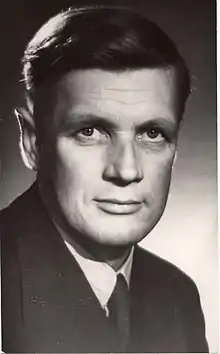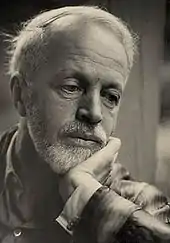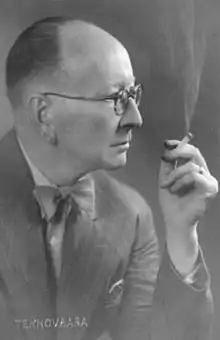

Uuno (Kalervo) Klami (20 September 1900, Virolahti – 29 May 1961, Virolahti) was a Finnish composer of the modern period. He is widely recognized as one of the most significant Finnish composers to emerge from the generation that followed Jean Sibelius.[1]
He was born in Virolahti. Many of his works are related to the Kalevala. He was influenced by French and Spanish music, and especially by Maurice Ravel, for whom he had a particular esteem.[2]
The core of Klami's oeuvre consists of an assortment of works related to the Finnish national epic, the Kalevala, among the most notable being: the five-movement Kalevala sarja (Kalevala Suite; 1933, r. 1943), inspired by Stravinsky's The Rite of Spring; the symphonic poem, Lemminkäisen seikkailut saaressa (Lemminkäinen’s Island Adventures; 1934); and, the unfinished ballet, Pyörteitä (Whirls), which survives as two suites. As central to Klami's legacy is the six-movement orchestral suite, Merikuvia (Sea Pictures; 1932); the Karelian Rhapsody (1927); and, Psalmus (1936), an oratorio for soloists, mixed, chorus and orchestra. He also wrote two numbered symphonies, in 1938 and 1945, respectively, as well as two piano concerti (1925, 1950), a Violin Concerto (1943), and the Cheremissian Fantasy for cello and orchestra (1931).
He participated in five armed conflicts, including two wars in Karelia, the Finnish Civil War, the Winter War of 1939–40 and the Continuation War of 1941–44.
Biography


.jpg.webp)
Klami studied music in Helsinki with Erkki Melartin and later in Paris and Vienna. Klami's Karelian Rhapsody, part of his first composition concert in 1928, was a succès de scandale that brought him considerable attention. His main works include the Kalevala Suite and the unfinished ballet Whirls. The oratorio Psalmus (1936) has a unique place in Finnish sacred music and is one of the most highly regarded works by a Finn other than Jean Sibelius. Klami also experimented with the symphonic form in his two Symphonies (1938 and 1945) and Symphonie enfantine (1927), and the concerto form in his two Piano Concertos (No. 1 Une nuit à Montmartre and No. 2 for Piano and Strings) and the Violin Concerto (1943). Being a master of miniature orchestral works, the orchestral suite Sea Pictures is also regarded as one of his major achievements. On the recommendation of Sibelius he was granted a small lifetime income from the government. In 1959 he was made a member of the Finnish Academy of Science and Letters (one of Finland's highest honors).
Klami died of a heart attack in Virolahti at age 60 while sailing his favorite boat "Miina".
Legacy
Reception and recordings
Acclaimed during his lifetime, Klami is today seldom heard outside the Nordic countries, the Kalevala Suite perhaps excepted.
The recording boom in the 1990s saw all of Klami's major works made available to the public, albeit often in only one interpretation per composition.
Despite these projects, much of Klami's oeuvre remains unrecorded (and unpublished), and he has received considerably less attention from record labels relative to fellow Finnish composers such as Leevi Madetoja, Aulis Sallinen, and Joonas Kokkonen.
Memorials
Founded in 1987, the Helsinki-based Uuno Klami Society exists to recognize the composer and to promote the publication, academic study, and performance of his music. At its first general meeting on 16 May 1988, the musicologist Helena Tyrväinen was elected chair; she held this post for 22 years until 2010. In addition, every five years, the Kymi Sinfonietta and the cities of Kotka and Kouvola (each located in the Kymenlaakso region of southern Finland in which Klami was born) co-host the International Uuno Klami Composition Competition, the goal of which is to increase international recognition of Klami and his music while expanding the repertoire of contemporary European works for a sinfonietta-sized orchestra. The inaugural event was held 2003–04, with subsequent iterations in 2008–09 (II), 2013–14 (III), and 2018–19 (IV). The Kymi Sinfonietta performs short-listed compositions at a finals concert and a jury (chaired by the Finnish composer Kalevi Aho) awards the three main prizes. There is also an audience prize and awards by the participating municipalities.
Honors and titles
- 1925: Diploma, the Helsinki Music Institute
- 1927: Composition prize of 3,000 marks, Hjalmar Pesonen Fund
- 1928: Grant of 10,000 marks, the Alfred Kordelin Foundation
- 1929: Grant of 10,000 marks, the Kordelin Foundation
- 1929–32: Music teacher, Folk Conservatory
- 1930: Music critic, Iltalehti and Ajan sana
- 1931: Music critic, Uusi Suomi
- 1932–59: Music critic, Helsingin sanomat
- 1932: Grant of 8,000, the Kordelin Foundation
- 1933: Grant of 12,000, the Kordelin Foundation
- 1935: Grant of 20,000 marks (from whom?)
- 1937: Grant of 15,000 marks (from whom?)
- 1938: Associate member, the Kalevala Society
- 1939–43: Annual State grant of 12,000 marks per year
- 1944: Grant of 150,000 marks, the Finnish Cultural Foundation
- 1945–47: Member, Society of Finnish Composers
- 1946: Grant of 50,000 marks, the Society of Finnish Composers' Sibelius Fund
- 1949: Founding member, the Finnish Contemporary Music Society
- 1950: Grant of 100,000 marks, the Sibelius Fund
- 1952: Grant of 100,000 marks, the Sibelius Fund
- 1957: Member, the Finnish delegation to the Second Assembly of the Composers' Union of the USSR
- 1958–61: Member of the Board, the Society of Finnish Composers
- 1959–61: Member, the Academy of Finland
- 1961: First Vice-chairman, the Kalevala Society
Select list of compositions
Symphonies
- Symphonie enfantine (Children's Symphony), for chamber orchestra, Op. 17 (1928); three movements[3][4][5]
- Symphony No. 1, for orchestra (1937–38); four movements[6][7]
- Symphony No. 2, for orchestra, Op. 35 (1945); four movements[6][4]
Concertante
- Piano Concerto No. 1, Une nuit à Montmartre (Night in Montmartre), for piano and orchestra, Op. 8 (1925); three movements[8][lower-alpha 1]
- Tšeremissiläinen fantasia (Cheremissian Fantasy), for cello and orchestra, Op. 19 (1931); two movements[9]
- Introduction e Staccato etude, for trumpet and chamber orchestra (1931–32)[10]
- Esquisse, for violin and strings (1932)[11]
- Intermezzo, for cor anglais and chamber orchestra (1937)[10]
- Violin Concerto, for violin and orchestra, Op. 32 (1939–43; rewritten 1954); three movements[12][13][lower-alpha 2]
- Piano Concerto No. 2, for piano and strings, Op. 41 (1950); three movements[8]
- Tema con sette variazioni e coda (Theme with Seven Variations and Coda), for cello and orchestra, Op. 44 (1953–54)[9][14]
Music for stage
- Intohimot jalavien varjossa (Desire Under the Elms), incidental music for clarinet, trumpet, violin, and piano (1930); play by Eugene O'Neill
- Arranged in 1931 by Klami as Rag-time and Blues, a quintet for the above instruments plus an additional violin
- Tuhlaripoika (The Prodigal Son), incidental music for male voice, choir, flute, clarinet, piano and strings (1945); play by Marin Držić (translation to Finnish by Jalo Kalima)[9]
- Pyörteitä (Whirls), unfinished ballet ("symbolic dance scenes") in three acts based on the Sampo legend from The Kalevala (1957–61):[15]
- Act I survives as a piano score by Klami (1958; orchestral score believed lost); it was orchestrated by the Finnish composer Kalevi Aho in the late 1980s and premiered in 1988[16]
- Act II (intended as a divertissement) is the only of the three acts that survives in Klami's orchestration; in 1960, he excerpted two ballet suites[17]
- Act III is either lost or was never written[18]
Voice and orchestra
- Psalmus, oratorio in two parts for soprano, baritone, mixed choir, organ, and orchestra (1932–36); text by Juhana Cajanus[15]
- Vipusessa käynti (In the Belly of Vipunen), symphonic poem (?) for baritone, male choir, and orchestra (1938); text from The Kalevala[19]
- Laulu Kuujärvestä (Song of Lake Kuujärvi), ballad for baritone and orchestra (1956); text by Yrjö Jylhä[20][21]
- Kultasauvallinen (The Bearer of the Golden Staff), cantata in four parts for soprano, baritone, mixed choir, and orchestra (1960–61); text by Martti Haavio[12]
Suites for orchestra
- Kohtauksia nukketeatterista (Scenes from a Puppet Theatre), suite for chamber orchestra (orchestrated in 1931; the original 1925 theatre score for two pianos is lost); five movements[8][22]
- Hommage à Haendel (Homage to Handel), suite for piano and strings, Op. 21 (1931); four movements[10][5]
- Kuvia maalaiselämästä (Scenes from a Country Life), suite for chamber orchestra (1932); six movements[23]
- Merikuvia (Sea Pictures), suite for orchestra (1930–32); six movements[20]
- Kalevala-sarja (Kalevala Suite), five tone pictures for orchestra, Op. 23 (1930–33; No. 3 added in 1943); based on stories from The Kalevala; five (originally four) movements[24]
- Sarja jousiorkesterille (Suite for String Orchestra) (1937); four movements[25][5]
- Sarja pienelle orkesterille (Suite for Small Orchestra), Op. 37 (1946); three movements[25][5]
Other works for orchestra
- Karjalainen rapsodia (Karelian Rhapsody), for orchestra, Op. 15 (1927)[24]
- Opernredoute, concert waltz for orchestra, Op. 20 (1929)[26]
- Sérénades joyeuses (Joyful Serenades), for chamber orchestra (1933); four movements[6][22]
- Helsinki March (1934)
- Lemminkäisen seikkailut saaressa (Lemminkäinen's Island Adventures), symphonic poem for orchestra (1934); based on The Kalevala; Klami's first attempt at composing a central scherzo for the Kalevala Suite, later removed and made an independent work[20][27]
- Karjalaisia tansseja (Karelian Dances), for chamber orchestra (1935)[25]
- Nummisuutarit (The Cobbler on the Heath), concert overture for orchestra (1936); based on the play by Aleksis Kivi[26][28]
- Suomenlinna, concert overture for orchestra, Op. 30 (1939–40; rewritten 1944); inspired by the islands; later renamed Linna meren äärellä (The Fortress on the Sea)[3][29][lower-alpha 3]
- Sérénades espagnoles (Spanish Serenades), for chamber orchestra (1944); four movements[6]
- Kuningas Lear (King Lear), concert overture for orchestra, Op. 33 (1944–45); unrelated to the stage music (chamber ensemble, 1936–37) of the same name[23][7]
- Pyöräilijä (The Cyclist), rondo for orchestra (1946)[15]
- Karjalainen tori (A Karelian Market), for orchestra, Op. 39 (1947)[24]
- Revontulet (Aurore boréale or Northern Lights), fantasy for orchestra, Op. 38 (1946–48); inspired by the natural light display[25]
- All'ouvertura, concert overture for orchestra, Op. 43 (1951)[30]
Chamber
- Sonata in B♭ minor, for viola and piano, Op. 6 (1920)
Notes, references, and sources
Notes
- ↑ The French subtitle comes not from Klami, but rather from the Finnish composer Ernest Pingoud.[8]
- ↑ The original version of the Violin Concerto (1943) was lost in Stockholm in 1944, prompting Klami to rewrite the piece in 1954. According to Heikki Poroila, the two versions are so different from each other that they "should be treated as independent works" ("Versiot ovat niin erilaisia, että niitä on syytä käsitellä itsenäisinä teoksi-na"). In 1957, the 1943 version of the concerto was found in the archives of the Swedish Broadcasting Corporation.[12][13]
- ↑ The original version of the Suomenlinna overture (1940) was lost in Germany during World War II, prompting Klami to rewrite the piece in 1944 based on his original sketches.[15][29]
References
- ↑ H. Tyrväinen (ODE 854–2) 1995, p. 3).
- ↑ Tyrväinen, Helena. "Klami, Uuno (Kalervo)". Grove Music Online. Oxford Music Online. Retrieved 27 February 2014. (subscription required)
- 1 2 H. Poroila 2012, p. 18.
- 1 2 T. Ollila-Hannikainen–Ondine (ODE858–2) 1996.
- 1 2 3 4 K. Aho (BIS–CD–806) 1997.
- 1 2 3 4 H. Poroila 2012, p. 17.
- 1 2 T. Ollila-Hannikainen–Ondine (ODE854–2) 1995.
- 1 2 3 4 H. Poroila 2012, p. 9.
- 1 2 3 H. Poroila 2012, p. 19.
- 1 2 3 H. Poroila 2012, p. 6.
- ↑ H. Poroila 2012, p. 5.
- 1 2 3 H. Poroila 2012, p. 10.
- 1 2 K. Aho (BIS–CD–696) 1997, p. 6.
- ↑ H. Tyrväinen (BIS–CD–676) 1994, p. 8–9.
- 1 2 3 4 H. Poroila 2012, p. 15.
- ↑ K. Aho (BIS–CD–696) 1997, p. 7–8.
- ↑ E. Salmenhaara (BIS–CD–656) 1994, p. 6–8.
- ↑ K. Aho (BIS–CD–696) 1997, p. 6–8.
- ↑ H. Poroila 2012, p. 20.
- 1 2 3 H. Poroila 2012, p. 12.
- ↑ E. Salmenhaara (BIS–CD–656) 1994, p. 5–6.
- 1 2 A. Häyrynen (ABCD 235) 2008.
- 1 2 H. Poroila 2012, p. 11.
- 1 2 3 H. Poroila 2012, p. 8.
- 1 2 3 4 H. Poroila 2012, p. 16.
- 1 2 H. Poroila 2012, p. 14.
- ↑ E. Salmenhaara (BIS–CD–656) 1994, p. 5.
- ↑ H. Tyrväinen (BIS–CD–676) 1994, p. 8.
- 1 2 K. Aho (BIS–CD–696) 1997, p. 5–6.
- ↑ H. Poroila 2012, p. 4.
Sources
Sources
- Aho, Kalevi & Valkonen, Marjo: Uuno Klami: Elämä ja teokset. Werner Söderström Osakeyhtiö, Helsinki, 1999. ISBN 951-0-25249-2
- Poroila, Heikki (2012). Yhtenäistetty Uuno Klami (List of Works by Uuno Klami). Helsinki: Suomen musiikkikirjastoyhdistys (Finnish Music Library Association). ISBN 978-952-5363-30-2.
- Korhonen, Kimmo: "Inventing Finnish Music." Finnish Music Information Centre 2003.
- Lehtonen, Tiina-Maija: "Uuno Klami: Works." Suomen Kultuurirahaston Kymenlaakson rahasto 1986.
- Tyrväinen, Helena: "The Success Story of the Man Who Forged the Sampo." Finnish Music Quarterly 2/2000 pp. 2–11.
Liner notes
- Aho, Kalevi (1997). Uuno Klami: Whirls, Act I / Violin Concerto / Suomenlinna (CD booklet). Osmo Vänskä & Lahti Symphony Orchestra. BIS. CD–696. OCLC 40569371
- Aho, Kalevi (1997). Uuno Klami: Symphonie enfantine / Hommage à Haendel / Suite for Strings / Suite for Small Orchestra (CD booklet). Jean-Jacques Kantorow & Tapiola Sinfonietta. BIS. CD–806. OCLC 39797823
- Salmenhaara, Erkki (1994). Uuno Klami: Whirls, Ballet: Suites 1 & 2 / Lemminkäinen's Island Adventures / Song of Lake Kuujärvi (CD booklet). Osmo Vänskä & Lahti Symphony Orchestra. BIS. CD–656. OCLC 31799770
- Tyrväinen, Helena (1994). Uuno Klami: The Cobblers on the Heath, overture / Theme with Seven Variations and Coda / Kalevala Suite (CD booklet). Osmo Vänskä & Lahti Symphony Orchestra. BIS. CD–676. OCLC 32530002
- Uuno Klami: Symphony No. 1 / King Lear Ouverture (CD booklet). Tuomas Ollila-Hannikainen & Tampere Philharmonic Orchestra. Ondine. 1995. ODE854–2.
{{cite AV media notes}}: CS1 maint: others in cite AV media (notes) (link) OCLC 36076621 - Uuno Klami: Symphony No. 2 / Symphonie enfantine (CD booklet). Tuomas Ollila-Hannikainen & Tampere Philharmonic Orchestra. Ondine. 1996. ODE858-2.
{{cite AV media notes}}: CS1 maint: others in cite AV media (notes) (link) OCLC 36076789
Further reading
- Tyrväinen, Helena: Kohti Kalevala-sarjaa: Identiteetti, eklektisyys ja Ranskan jälki Uuno Klamin musiikissa. (Dissertation.) Acta Musicologica Fennica, 30. University of Helsinki, 2013. ISSN 0587-2448. ISBN 978-951-98479-9-3. 978-951-98479-9-3 On-line version.
External links
- Information on Klami at the Wayback Machine (archived May 3, 2008)
- Uuno Klami Society's main page (in Finnish)
- International Uuno Klami Composition Competition